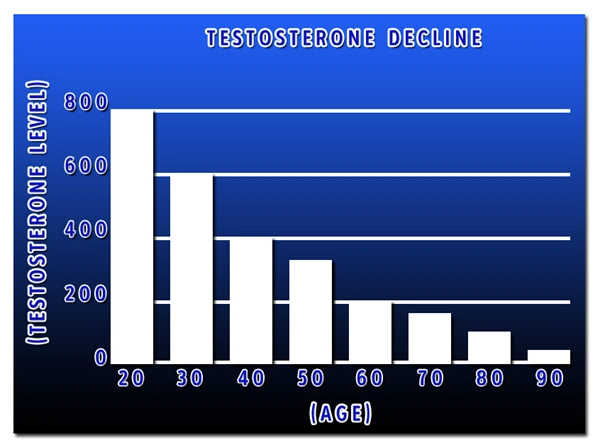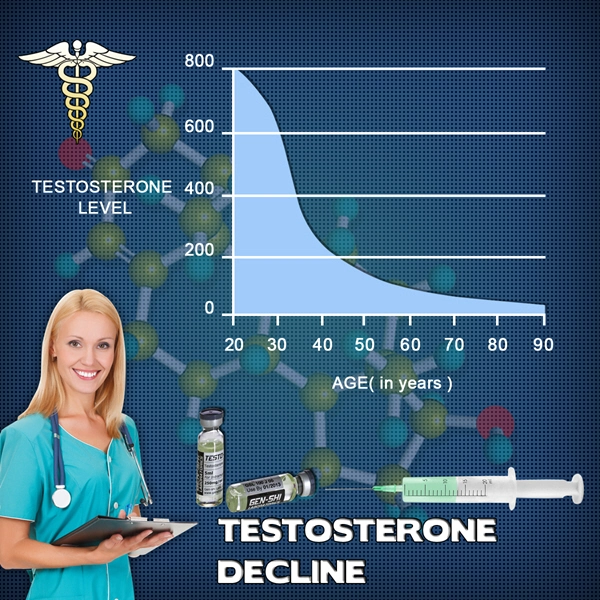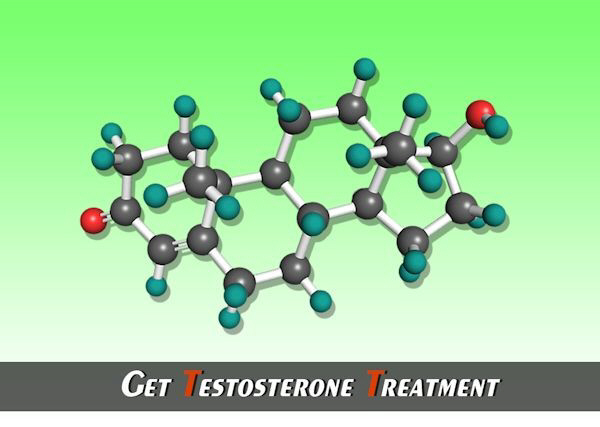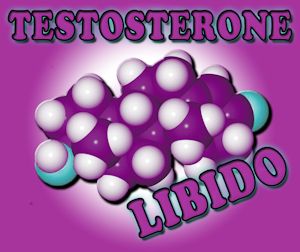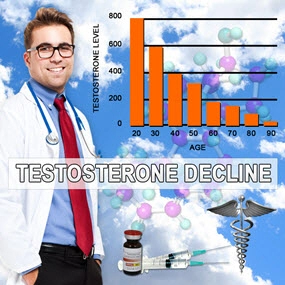Video Link: https://vimeo.com/282903290
Video Download: Click Here To Download Video
Video Stream: Click Here To Stream Video

As we learn more about testosterone deficiency and how our bodies respond to declining testosterone levels, we periodically revise our strategies regarding the determination of low-t.
Every patient is different and responds to declining testosterone production in their own way, but there are defined clinical limits to what is considered normal testosterone levels and what is characterized as low-t or andropause.
What is the Testosterone Normal Range?
The clinical range for establishing healthy testosterone levels consists of two values. If your testosterone levels are lower than the base of the range, then you are considered testosterone deficient. The healthy testosterone range is referred to as either the normal range or the reference range.
Any value that falls outside of this range is grounds for further examination. Abnormally high testosterone levels are associated with testosterone abuse and cancer, low testosterone volume is a sure sign of low-t.
When you meet us for clinical hormone evaluation, we primarily use Labcorp as the diagnostic testing firm of choice. We utilize the efficient diagnostic capabilities of Labcorp to provide you with fast and accurate diagnoses of hormone imbalance and deficiency.
Recently, Labcorp adjusted the way that they evaluate your testosterone levels. Previously, the normal range for testosterone was 348 ng/dL to 1,197 ng/dL.
Today, their recommended reference range has been adjusted to 264-916 ng/dL. This means that they have reconsidered their previously stated position and now feel that slightly lower testosterone levels are considered normal than before.
What Do LabCorp Changes Mean for Men Interested in Testosterone Therapy?
Because Labcorp performs such a large volume of low-t evaluations and blood tests, it is considered an industry standard for the diagnosis and treatment of many conditions, such as testosterone deficiency.
The original reference range has been used for over a generation to establish a clinical need for low-t treatment.
The reason that Labcorp has adjusted their normal range is that of ongoing clinical research from the Center for Disease Control, the CDC.
For a long time now, different laboratories and lab testing companies have more or less independently set their normal and ideal testosterone ranges, measured in a variety of ways. The CDC's effort is a move toward low-t standardization.

Of course, as usual with changes like this, the story is more complicated than it may seem at first glance.
Though the CDC has adjusted its suggested normal range, the reason that Labcorp made its decision is mostly the result of changing theories concerning testosterone and body mass index (BMI).
To further explain, the reference range is considered to be the values between which 95% of individuals are perceived to be healthy.
These changes reflect what is considered “healthy” for people that are overweight.
One of the most significant problems with this means of low-t determination is that it relies on arbitrary consideration of what is healthy.
The BMI is used as a rule-of-thumb for establishing lean muscle mass vs. body fat in an individual. A higher BMI is associated with being overweight or obese.
How is BMI Calculated? What are the Flaws of BMI as a Health Indicator?
BMI is a relatively simple calculation derived from dividing weight by height. As you can imagine, there are flaws in how BMI correlates to real body fat percentage, but it works decently in place of more thorough tests.
The biggest weakness in BMI is that there is no way to consider muscle mass in the calculation.

Muscle naturally weighs more than fat per volume. This means that individuals that go to the gym frequently or work in hard labor may have elevated BMI but still be perfectly healthy.
This also means that folks that are sedentary may be more unhealthy and more at risk than their BMI suggests.
The second problem is that BMI correlates to health differently for different genetic and hereditary groups.
For example, Native Americans and Asians are at elevated risk for many dangerous conditions even when they are in the average BMI Range.
About testosterone levels, BMI is significantly flawed. While it is very real that higher body fat percentage has a powerfully suppressive effect upon testosterone levels, there are a variety of factors that also have an impact on testosterone, including smoking, sedentary lifestyle, poor sleep quality, and more.
New Reference Range Does Not Adequately Reflect Reality for All Low-T Patients
 The study that led to these changes in the reference range (“Harmonized References Ranges for Circulating Testosterone Levels in Men of Four Cohort Studies in the United States and Europe”) does not consider all factors regarding what is or isn't a healthy lifestyle.
The study that led to these changes in the reference range (“Harmonized References Ranges for Circulating Testosterone Levels in Men of Four Cohort Studies in the United States and Europe”) does not consider all factors regarding what is or isn't a healthy lifestyle.
Many individuals that have a healthy BMI still have co-mingling factors that impact testosterone production.
Luckily, these guidelines are not set in stone, and hormone clinics across America have the right to act in their patient's best interests as they see fit.
This overly broad definition of"healthy" has the potential to prevent many men from getting the testosterone therapy treatments that they deserve because individuals have such a propensity to behave in ways that superficially suppress testosterone levels.
Our Hormone Clinic Uses Professional Judgement to Assess Low-T Risk
It's important to note that LabCorp is a massive corporation with a lot of pull and sway. Due to their size, it benefits them greatly to follow national policy concerning hormone deficiency guidelines.
At our licensed and board-certified HRT clinic, we have experienced endocrinologists and hormone doctors that have spent their lives working with patients suffering from age-associated hormone imbalance.
They understand that these guidelines are overly limiting, and may prevent many patients that can benefit from testosterone from receiving treatment.
The Definition of Good Health
Our wellness clinic also recognizes that there is a considerable difference between good health and lack of illness.
The goal of our clinic isn't just to ward off disease, but to facilitate optimal health. For that reason, we will continue to use our own judgment to assess your needs as a patient.
We feel that many needy patients may be left out in the cold if we adapt our policies to these updated guidelines. Though we use Labcorp to facilitate blood testing, our hormone specialists follow their own guidelines and modify their evaluation of low-t diagnosis to the individual characteristics of the patient.
Interested in Testosterone? Call Us Today!
 If you feel that you may be a candidate for testosterone replacement therapy, we encourage you to reach out to our clinic for an accurate hormone deficiency diagnosis tailored to your own needs.
If you feel that you may be a candidate for testosterone replacement therapy, we encourage you to reach out to our clinic for an accurate hormone deficiency diagnosis tailored to your own needs.
We use only the most effective treatment regimens, and we use a comprehensive approach to combine bio-identical hormones with positive lifestyle changes to provide you with the best possible results.
We understand the subtleties of testosterone deficiency, and won't rely on imperfect clinical trials as a shortcut to thorough and personal evaluation!
Contact Us Today For A Free Consultation

- Testosterone for Women [Last Updated On: December 1st, 2023] [Originally Added On: December 29th, 2013]
- Testosterone Androgen [Last Updated On: December 11th, 2023] [Originally Added On: December 29th, 2013]
- Testosterone and Body Building [Last Updated On: December 14th, 2023] [Originally Added On: December 30th, 2013]
- Testosterone Levels [Last Updated On: December 6th, 2023] [Originally Added On: December 31st, 2013]
- Testosterone Gel, Cream, and the Testosterone Patch [Last Updated On: November 28th, 2023] [Originally Added On: December 31st, 2013]
- Buy Testosterone | Types of Testosterone Replacement Therapy Programs, Injections, Cream and Gel [Last Updated On: December 13th, 2023] [Originally Added On: December 31st, 2013]
- Buy Testosterone Injections Online, Testosterone Prescription for Low T, Testosterone Replacement Therapy [Last Updated On: October 16th, 2020] [Originally Added On: January 1st, 2014]
- Aging and Testosterone Replacement Therapy [Last Updated On: December 12th, 2023] [Originally Added On: January 3rd, 2014]
- What Causes Low Testosterone [Last Updated On: December 10th, 2023] [Originally Added On: January 7th, 2014]
- Hormone Levels in Men [Last Updated On: December 4th, 2023] [Originally Added On: January 12th, 2014]
- Hormone Level Testing [Last Updated On: November 29th, 2023] [Originally Added On: January 13th, 2014]
- Types of Testosterone Products and Delivery [Last Updated On: December 8th, 2023] [Originally Added On: January 22nd, 2014]
- Testosterone Therapy Helps Men with Low-T Ward Off Prostate Cancer [Last Updated On: May 29th, 2024] [Originally Added On: December 29th, 2019]
- The Importance of Dietary Fat for Testosterone Production [Last Updated On: July 8th, 2024] [Originally Added On: January 2nd, 2020]
- Testosterone Deficiency and Low-T at Epidemic Levels Among Men in the United States [Last Updated On: May 27th, 2024] [Originally Added On: May 17th, 2020]
- The Effects of Testosterone Therapy on Male Patients -- Who Should Use Testosterone? [Last Updated On: December 20th, 2023] [Originally Added On: June 16th, 2020]
- Does Ibuprofen Contribute to Low Testosterone? [Last Updated On: January 27th, 2024] [Originally Added On: June 20th, 2020]
- The Link Between Testosterone and Lower Rates of Autoimmune Diseases Among Men [Last Updated On: January 30th, 2024] [Originally Added On: June 21st, 2020]
- Weight Cycling and the Problem with Crash Dieting [Last Updated On: April 8th, 2024] [Originally Added On: July 30th, 2020]
- Reexamining Bio-Identical Testosterone Therapy [Last Updated On: June 18th, 2024] [Originally Added On: August 12th, 2020]
- Understanding how Muscle and Fat Impact Body Mass, Weight, and Health [Last Updated On: April 15th, 2024] [Originally Added On: August 25th, 2020]
- The Role of Nitric Oxide in Cancer Proliferation And Prevention [Last Updated On: May 3rd, 2024] [Originally Added On: August 26th, 2020]
- Understanding Heartburn in the 21st Century [Last Updated On: April 24th, 2024] [Originally Added On: August 28th, 2020]
- What is Erectile Dysfunction? [Last Updated On: April 20th, 2024] [Originally Added On: August 30th, 2020]
- Sermorelin Acetate Drug Information [Last Updated On: April 7th, 2024] [Originally Added On: August 31st, 2020]
- Exercise and Mental Health [Last Updated On: April 5th, 2024] [Originally Added On: September 1st, 2020]
- The Importance of Proteins, Carbs, and Fats [Last Updated On: March 11th, 2024] [Originally Added On: September 2nd, 2020]
- Low-T Treatment Before and After -- How Testosterone Therapy Improves Vitality [Last Updated On: April 9th, 2024] [Originally Added On: September 6th, 2020]
- The Effects of Testosterone on Asthma Prevalence Among Men and Women [Last Updated On: February 19th, 2024] [Originally Added On: October 6th, 2020]
- 7 Exercises to Elevate Testosterone Levels [Last Updated On: June 13th, 2024] [Originally Added On: October 10th, 2020]
- Vitamin A is Essential for Good Health - Are You Getting Enough ? [Last Updated On: April 16th, 2024] [Originally Added On: October 14th, 2020]
- Testosterone and Diet – How to Support Testosterone Levels with Healthy Eating [Last Updated On: June 7th, 2024] [Originally Added On: October 29th, 2020]
- The Significance of Telomeres in Stem Cell Treatments [Last Updated On: March 16th, 2024] [Originally Added On: November 27th, 2020]
- The Influence of Testosterone on Protective Mating Behaviors in Men [Last Updated On: January 25th, 2024] [Originally Added On: December 6th, 2020]
- The Role of Testosterone in Women's Health [Last Updated On: December 24th, 2023] [Originally Added On: December 7th, 2020]
- Testosterone Promotes Bone Health and Can Help Treat Osteoporosis [Last Updated On: February 15th, 2024] [Originally Added On: December 17th, 2020]
- The Relationship Between Testosterone and Cortisol [Last Updated On: April 2nd, 2024] [Originally Added On: December 19th, 2020]
- The Importance of Sex Hormone-Binding Globulin (SHBG) for Healthy Testosterone Levels [Last Updated On: March 9th, 2024] [Originally Added On: December 28th, 2020]
- 12 Health Issues That Can Kill Libido and Limit Sexual Performance [Last Updated On: May 23rd, 2024] [Originally Added On: January 3rd, 2021]
- 4 Foods to Boost Your Testosterone Levels [Last Updated On: February 7th, 2024] [Originally Added On: January 4th, 2021]
- Low Testosterone Symptoms [Last Updated On: December 31st, 2023] [Originally Added On: January 7th, 2021]
- Is Male Menopause Real? The Science of Andropause [Last Updated On: January 15th, 2024] [Originally Added On: January 11th, 2021]
- Relieve Fatigue and Increase Energy with Testosterone Replacement Therapy [Last Updated On: January 16th, 2024] [Originally Added On: January 16th, 2021]
- How to Administer a Testosterone Injection -- Low-T Injection Guide [Last Updated On: February 28th, 2024] [Originally Added On: January 17th, 2021]
- Testosterone Levels Associated with Serotonin Activity in the Brain [Last Updated On: March 26th, 2024] [Originally Added On: January 19th, 2021]
- Grumpy Old Man Syndrome – Causes and Treatments [Last Updated On: June 8th, 2024] [Originally Added On: January 22nd, 2021]
- The Effects of Beer on Testosterone Production and Gynecomastia [Last Updated On: March 21st, 2024] [Originally Added On: January 30th, 2021]
- Testosterone Frequently Asked Questions [Last Updated On: February 6th, 2024] [Originally Added On: February 26th, 2021]
- Testosterone Supplements: Vitamin and Amino Acid Pills Versus Real Testosterone [Last Updated On: November 21st, 2024] [Originally Added On: March 1st, 2021]
- Testosterone Side Effects, Risks, Dangers and Negative Effects [Last Updated On: November 7th, 2024] [Originally Added On: March 2nd, 2021]
- Testosterone for Men [Last Updated On: February 20th, 2024] [Originally Added On: April 13th, 2021]
- Testosterone Testing [Last Updated On: November 9th, 2024] [Originally Added On: May 7th, 2021]
- Hormone Replacement Therapy: Commonly Asked Questions [Last Updated On: February 20th, 2024] [Originally Added On: June 16th, 2023]
Word Count: 1148

